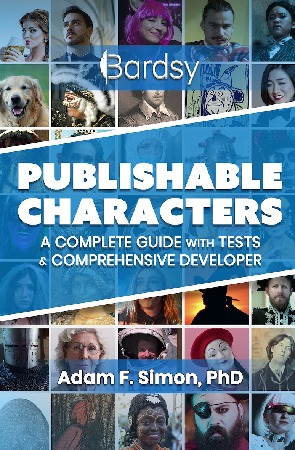😃 Subscribe for Weekly Posts:


This approach composes and blends a character into an integrated, believable being
If you've been working along with this blog series, you now have the core parts of your budding character's identity. If not, here are the links you need to catch up:
Remember, this approach to constructing characters presumes an underlying truth: fictional beings are thought of in the same way as actual people. This fact makes an author's' primary goal simple. Your fictional beings must be authentic and investible in order for readers to relate to them as if they were real. Only this relationship can provoke the deep empathy successful novels need.
Unlike real people, however, fictional characters require deliberate, careful construction. Why? Because they don't occur naturally! A lot of work goes into creating an identity that is realistic, relatable, and someone your readers will root for. So, this approach composes and blends a character into an integrated, believable being, someone that your readers will empathize with and remember long after they've read the last page. Our freshly published guide Publishable Characters: A Complete Guide With Tests & Comprehensive Developer presents this thinking in full.
Composition vs. Blending
This week's post presents the second half of this recipe: blending. The idea is to use interactions to turn the three Character Equation ingredients: Parts of You, Cultural Universals and Specific Referents into a relatable person. Like any recipe, piling a bunch of ingredients on the counter doesn't make a meal. In a few words, your character needs to be cooked. Thus, the Character Equation provides a strong foundation while blending makes them feel whole and cohesive.
Blending ensures your character meets the two key criteria: authenticity and investability. Under authenticity, you can hold the character in your mind as a whole being. Under investability, readers can understand and empathize with the character. The aim is not mechanical perfection, but a cohesive, lifelike personhood.
The immediate task is to blend the three ingredients until they're inseparable, like a smoothie, and not a salad or a strew. (Choose the simile that tastes best.) The character should feel whole and uninterrupted after blending. Avoid acting like Dr. Frankenstein and stitching together random pieces—you don't want any noticeable or mismatched parts! The monster's seams, bolts, and poor fit signal failure. A character so haphazardly thrown together like this is neither authentic nor investible. The idea is that a natural individual is a seamless blend of nearly infinite influences, and a good character must attain this seamlessness to be knowable, relatable, and interactable—capacities all ordinary people have. And blending is easily your remedy for a bad case of Frankenstein's monster.
With a viable set of components, mixing them takes less work than you may think. It's almost an automatic process, a fringe benefit that comes with interacting with your character. And this is what we recommend. Interaction is the trick! The more you treat them as a real person, the sooner they will feel like one. So draw them, talk to them, joke with them. You're not looking to identify any one trait or aspect, but rather engage with their entirety like a real person. The process is like a performance, a rehearsal for life, in which you play two roles: you and your character.

Four blending tricks let you explore your character. Each seeks to encourage interaction and stabilize your simulacrum.

Four Blending Tricks
Here are four blending tricks to explore and learn about your character. Each activity seeks to encourage interaction and stabilize your simulacrum.
One: Find a picture. Once you have vaguely visualized your creature, firm up that mental image with an actual image. You're ahead if you can paint or draw. No matter your skill set, sketch your character as best you can, knowing you can update their look later. You can even adapt an existing image. This portrait helps fix them in your mind and provides an icon on which to center your interactions.
Two: Make a recipe. Chart your character's components. Create a table with three roles and one column for every major character. The three rows should be taken from the character equation; author, stereotypes or archetypes, and referents. As you work through your story and come to know your beings, they'll change. Don't worry about the stability during drafting. Growth in characters only mirrors real humans! But be sure to fix the character once the story has stabilized during revision.
Three: Play icebreakers. You can and should play icebreakers with your characters. Try Two Truths and a Lie and have your character dream up two true statements and one false statement. Try Would You Rather, and have your character answer thought-provoking questions, like "would you rather be smarter or stronger?" The point of these icebreakers is to get your character talking. Any dialogue with your character will help fill areas their simulacrum is missing.
Four: Borrow professional techniques. Authoring eventually involves roleplay. Draw from roleplay and acting methods to put yourself in their headspace. Aim not to act like them, but to impersonate them. It goes without saying that executing this advice takes subtlety. You can't give your character a hat and be done, though amazingly, a cap could be very useful to you as an author— a talisman that gives you the ability to become your character. Sometimes a prop or a gesture, like a posture or a catchphrase, can lock a persona in place. You can use the same trick as you write.
A Word of Caution
As you practice these blending techniques, watch out for inconsistency. If the parts of your character don't fit together naturally, readers will feel it immediately. Forced traits, sudden shifts in motive, or details that don't align with their established nature can make your character feel poorly stitched together. Blending only works when every piece belongs to the same whole.
You may also notice that your character comes together without a part you wanted, and that's okay! Don't fight it. It means you've subconsciously ejected it from the developing simulacrum. If you really wanted an aspect included, especially if your plot hinges on it, we'd advise starting over from scratch and reevaluating everything in the original recipe list. Tacking on a disconnected trait to further the plot will only make your character feel incohesive at best, and like a cheap caricature at worst.
Blend like a Bard!
In all, publishable characters are finely blended combinations of the same parts every being has. A fictional being's components fall into three categories: the author, the universal, and the distinct. Your job is to make sure these puzzle pieces fit perfectly together, solidifying your being and bringing them to life through thoughtful integration and imaginative interaction.
Remember to use our Comprehensive Character Developer, to construct your being online for an extra boost. It produces a downloadable character sheet pdf. And stay tuned for the next step in this two part process: blending.